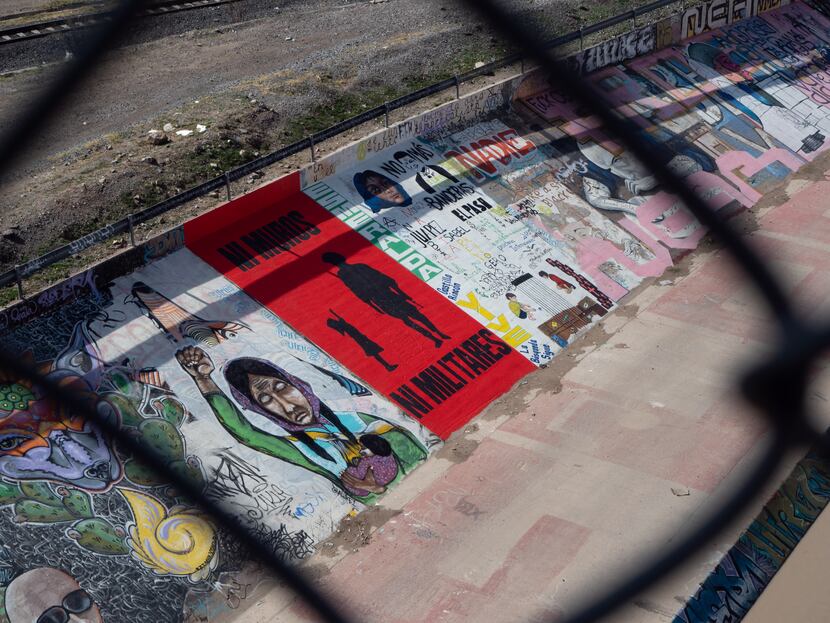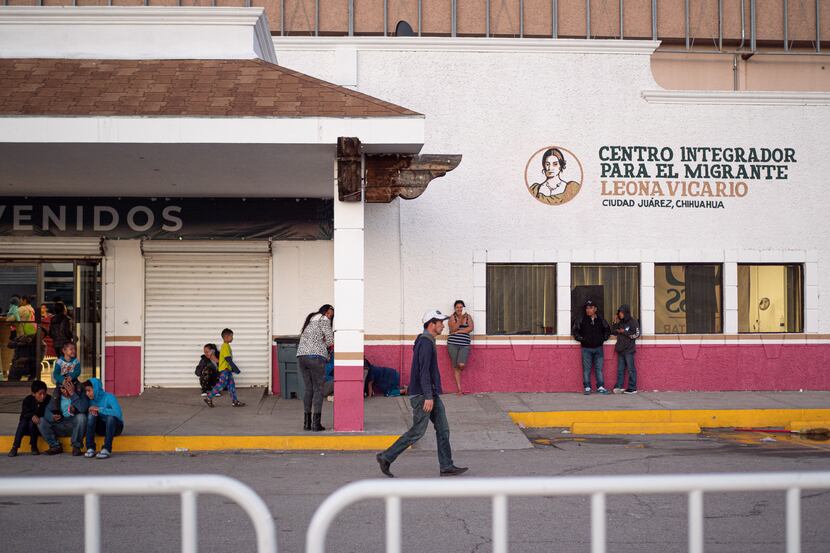CIUDAD JUAREZ, Mexico – At one point, Alberto was far from the only Mexican asylum seeker in this sprawling border city of binational industrialists and workers.
They camped out by the hundreds at the Chamizal Park or on international bridges like foreigners in their own land. All waited to press their pleas about persecution to U.S. officials.
Then, they were nowhere to be found.
Some were forced out of Ciudad Juarez by a Mexican government agency, Alberto and immigrant rights advocates say. Others, like Alberto, were threatened with deportation to violent, crime-ridden Guatemala by U.S. immigration officials.
But Alberto stubbornly stayed. He couldn’t return home to his Pacific Coast state, where criminal groups, he said, had already killed his father. He now bides his time surrounded by Central Americans in one of the city’s many shelters, one of the few Mexicans still trying to get into the U.S.
“Solo,” said Alberto, who asked that his full name not be published because he fears for his life. “I’m all alone.”
The U.S. asylum process for the desperate and displaced has been crushed by the Trump administration through a series of restrictive policy changes that began in 2018 and now keep thousands waiting in Mexican border cities.
The first to recognize this were the Mexicans themselves. That’s why Mexican asylum seekers have nearly vanished here in a region that for a century provided passage to those seeking safe refuge.
How and why Mexicans suddenly dispersed illuminates the delicate political situation for Mexican President Andres Manuel Lopez Obrador, who is pinned in by drug cartels, whose economy is struggling and who must keep President Donald Trump happy. Mexico’s decades-long economic integration with the U.S. is something Trump quickly learned to leverage with his tariff threats.
“Mexico in no time in history has been so dependent on the U.S.,” said Guadalupe Correa-Cabrera, a global fellow at the D.C.-based Wilson Center and a government professor at George Mason University.
The ‘Rescue’
To reduce numbers in Juarez, Mexicans have been physically relocated, immigrant rights advocates and immigrants say. The Mexican government said it “rescued” families by pressuring adults, many with children, away from outdoor camps and to shelters for their own well-being.
As many as 3,000 Mexican migrants packed into shelters and temporary lodging in Juarez last fall. By year’s end, it was difficult to find the Mexicans. Reasons varied. Some say many Mexicans gave up on asylum and attempted to cross the border between the ports of entry. Others blended into Juarez and took jobs. Others went to other border cities.
But the Mexican government forced some away from high-visibility spots where they camped, said Tania Guerrero, who heads the U.S. office of a Catholic legal nonprofit called CLINIC in Juarez and documented testimonies from migrants themselves.

Their move, coming days before Lopez Obrador arrived in Juarez for a January visit, eliminated the embarrassment of a media spotlight on Mexicans seeking asylum from their birth country. Even worse, there were more Mexicans waiting for U.S. asylum than any other group, including Central Americans, said a state official.
A February update to a university study on migrant “metering” at international bridges could find no Mexican asylum seekers in Ciudad Juarez. The asylum seekers are believed to have traveled to other border cities, particularly to those where a new fast-track program for Mexicans has not been implemented, according to the Central America/Mexico Policy Initiative at the Robert Strauss Center for International Security and Law at the University of Texas in Austin. The fast-track program is known as the Humanitarian Asylum Review Process, or HARP.
Fusion of nations
The binational politics of Mexico and the United States have resulted in the fusion of trade policy with immigration policy, a combustible dynamic. Mexico’s economy was lagging last year, and even contracted slightly in 2019, making Mexico even more vulnerable to the wishes of the north. About 80% of Mexican exports are U.S.-bound, accounting for hundreds of thousands of jobs in Mexico.
Some experts, however, say the country of 126 million has more leverage than it realizes. They point to the deep integration with key U.S. states, from Ohio and Michigan to Texas, whose billion-dollar trade and cultural ties are especially intertwined.
“It’s a very asymmetrical situation, for sure, but I think in any asymmetrical situation there is a degree of power in the hands of the weak,” said Emilio Kouri, a noted historian and director of the Katz Center for Mexican Studies at the University of Chicago.
Punch Mexico and the U.S. takes the blow, too; such is the fusion, Kouri said. Because of the integration with goods and demographics, “hitting Mexico very hard also hits the United States. The pain will be there for both sides.”
Guerrero calls the integration “a sickening dependency.” A U.S.-trained lawyer who was born in Mexico, she said she was surprised at how Mexico’s president has conformed to the U.S. president’s wishes.
“I voted for a president who puts his people first,” Guerrero said of Mexico’s Lopez Obrador. “I believe that he should fight for the opportunity to protect, serve and honor those inside the Republic of Mexico. He’s not doing that. He is not.”
The White House didn't return calls seeking comment.
An official with Mexico’s Foreign Ministry who asked for anonymity because the official was not authorized to comment said that, to remove Mexicans requesting asylum, the government took actions such as offering “thousands of jobs to our citizens living at the campsites” and “mobilized to provide them with housing and health care” through a network of shelters in Juarez.
The official denied Mexicans were forcibly removed, adding, “In many cases, these individuals ultimately decided to return voluntarily to their communities.”
Asylum chaos
Mexican asylum seekers fleeing violence are in a precarious situation.
“Most of these people are running away from either threats or violent situations going on in their home communities,” said Enrique Valenzuela, Enrique Valenzuela, head of the Chihuahua State Population Council. “Many of them have actually been victims.”

Two of the newest asylum measures are intended to speed cases through a civil court system clogged with a 1.1 million-case backlog. HARP is aimed at Mexican asylum seekers. About 1,250 Mexicans had gone through that program by late February.
Three-fourths of the Mexican cases came through El Paso.
The other fast-track program is the Prompt Asylum Claim Review, or PACR, and generally affects non-Mexicans.
A third controversial policy sends deportees to Guatemala – but no Mexicans have been among the nearly 900 sent south yet, a Guatemalan migration official said. Only 16 people there had applied for asylum.
This week, the Supreme Court gave the Trump administration a victory with a ruling that its “Remain in Mexico” program could continue. The biggest tool in Trump’s asylum-blocking kit, it has sent 61,000 people back into Mexico to wait for their asylum hearings in the U.S. Mexicans, though, aren’t supposed to be part of that program, known officially as the Migrant Protection Protocols.
Earlier in 2018, border encampments sprouted in Mexico when the “metering” system began in which only a few people were allowed to petition for asylum at the bridge daily.
In Mexico, perhaps the biggest effort to slow the flow of asylum seekers came with the creation of a human wall, courtesy of some 20,000 Mexican National Guardsmen who helped seal the border from any migrant trying to cross, including Mexicans.
Combined, the Trump administration’s efforts and Mexico’s efforts appear to be paying off, though the situation remains fluid. For now, monthly apprehensions are down to fewer than 40,000 from a high of 140,000 last May.
Trump administration officials justify the tough measures in the media of choice, Twitter.
“Instead of putting all your hopes in coming to the United States, put your hopes in your own country,” tweeted Mark Morgan, acting commissioner for U.S. Customs and Border Protection. “Maintain your hope in your leaders. Support your community. Help build your country and your future, rather than leaving it behind.”
If only that was as easy as it sounded. Some Mexicans say they are stranded, feeling they have no country of refuge.
The despair comes as violence hits a new peak. More than 36,000 people were killed in Mexico in 2019, the most since authorities began tracking numbers in 2006. An additional 60,000 were “disappeared,” a term used by human rights activists, including the National Search Committee.
Public opinion
More worrisome for some experts is the growing indifference displayed by Mexicans themselves, making them as complicit in the U.S. restrictions as Lopez Obrador, said Carlos Bravo, an analyst and associate professor and coordinator of the journalism program at the Center for Economic Research and Teaching in Mexico City.
“Mexican public opinion has come out and generally said, ‘We agree with becoming Trump’s wall to stop Central Americans from crossing into the United States,’ which goes completely against the historic grain on how to treat immigrants, because of Mexicans in the U.S.,” he said. “So even now with Trump threatening to deport Mexicans to Guatemala, the attitude here is this is just one more step in a long chain of Mexico disengaging from its own cause, its own people, its own history. We’re betraying our history.”
Alberto sees an attitude of indifference, a lack of empathy, among his own people. He said he’s running from hit men who shot his father in the head and gave him three hours to decide whether he would join the gang and warehouse their illicit goods on his vast northern Mexican farm. Join the gang or die, they said.

Alberto documented the violence he faced. He took pictures of his bullet-riddled farm, destroyed by cartel members who shot up his cattle, his house and then, horrifically, his father.
Alberto refrained from reporting to police authorities out of suspicion that they were on the cartel payroll. Instead, he sent photos to his estranged wife, already in the U.S. with his children. The cartel took a picture of him and threatened to post it on a social media site, he said. This made hiding especially hard, he said. He said he was constantly paranoid. His account couldn’t be independently confirmed.
After the threat on his life, he went into hiding, crisscrossing the northern states of Sonora, Sinaloa and Durango, hoping tensions would abate. They didn’t. One night, he hit the road for Texas.
“I realized my life is worth more than a piece of land, even though it’s a lot of land,” he said. “There is no corner in Mexico that I can hide in without being discovered.”
In October, he arrived in Juarez, a city then packed with other asylum seekers, all from Mexico. He took a number under the metering system at the international bridge. He waited for his turn with U.S. authorities who would give him a “credible fear” interview, a crucial first step in the asylum process. Daily, he stayed by the bridge or the park, withstanding taunts and insults not just from U.S. authorities but also from frustrated Mexican motorists who would honk, spit and yell obscenities at him.
“Sometimes I had to remind myself that I’m in Mexico, that this is my country, even when I feel like a foreigner here,” he said, surrounded at the shelter by Central Americans, including children glued to the television watching cartoons.



